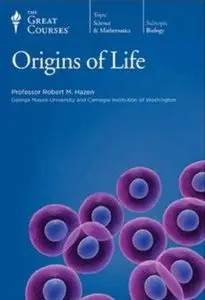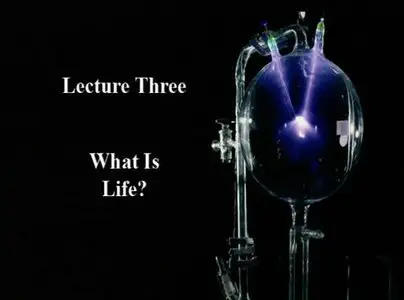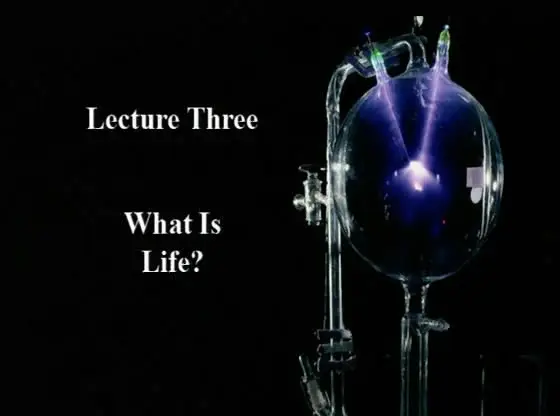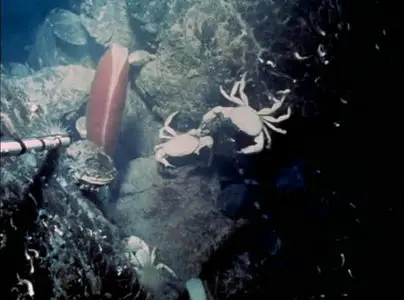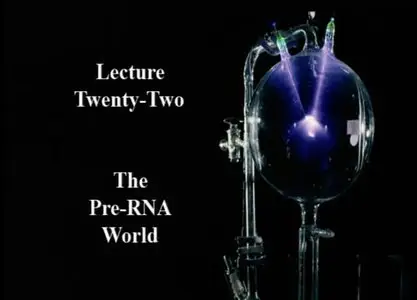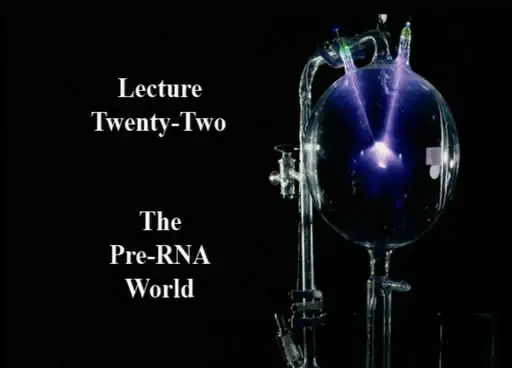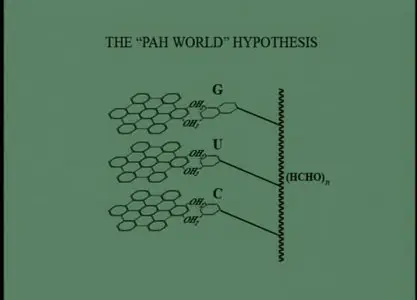Origins of Life
24xDVDRip | AVI/XviD, ~977 kb/s | 512x368 | Duration: 12:16:20 | English: MP3, 128 kb/s (2 ch) | 5.49 GB
Genre: Biology, Chemistry, History
24xDVDRip | AVI/XviD, ~977 kb/s | 512x368 | Duration: 12:16:20 | English: MP3, 128 kb/s (2 ch) | 5.49 GB
Genre: Biology, Chemistry, History
Four billion years ago, the infant Earth was a seething cauldron of erupting volcanoes, raining meteors, and hot noxious gases, totally devoid of life. But a relatively short time later—100 to 200 million years—the planet was teeming with primitive organisms. What happened?Professor Robert M. Hazen, one of the nation's foremost science educators and leader of a NASA-supported team that is studying the origins of life in the universe, leads you on a 24-lecture expedition to find the answer to this momentous question.
The search takes you from path-breaking experiments in the 19th century proving that the molecules of life are no different from other chemicals, to the increasingly sophisticated understanding in the 20th century of how the chemistry of life works, to the near certainty that the 21st century will see spectacular and unpredictable developments in our understanding of how life began.
From Simple Chemistry to DNA
For all its familiarity, life is an elusive concept that is hard to define, much less explain. This course shows how scientists are systematically building a picture of the process by which chemical reactions on the early Earth eventually led to the first appearance of the DNA-protein world that remains the fundamental basis of all life today.
Dr. Hazen's own work makes him the perfect guide to present key ideas and controversies in this research, and to introduce you to the most important scientists working in the field—many of whom he knows personally. Under his guidance, you will join researchers as they seek to establish the earliest appearance of life on Earth, as they grapple to explain how it arose, and as they probe for evidence of life beyond our planet.
Dr. Hazen is a superb science teacher, whose previous course for The Teaching Company, The Joy of Science, earned this accolade in AudioFile magazine: "From the very beginning, one recognizes the gift of Professor Hazenàto make science easy to understand."
This course is crammed with fascinating experiments, surprising results, heated debates, blind alleys, and promising leads. It is a mystery story in the truest sense—one in which the clues are slowly adding up but the solution is not yet in hand.
Not Your Usual Science Course
The Origins of Life introduces you to a scientific problem that is far from solved but one which is all the more thrilling for that reason. "The most exciting aspect of science is the process of discovery," says Dr. Hazen. "The origin of life is a perfect subject to reveal that ongoing adventure that is the very essence of science."
This is not your usual science course, which traditionally presents a consensus view on known facts about the world. Instead, Professor Hazen plunges into the thick of ongoing research. "I want to take you into the field to see what the geologists see, and to puzzle with them as they try to sort out the meanings of ancient rocks. I want to take you into the laboratory and show you how we do origin experiments. I want you to see how unscripted and creative the scientific process really is. I want you to get a sense of how scientists around the world are trying to fill in the blanks of our ignorance."
"We are in the midst of a remarkably dynamic stage of research into the origin of life," he continues. "I've never seen a scientific field with so many wild new ideas."
Intriguing Theories
What are some of these ideas?
Life from the Bottom of the Sea: The discovery in the 1970s of flourishing communities of microbes around hydrothermal vents at the bottom of the sea raises a fascinating possibility. Perhaps life formed in the ocean depths, far from the sunlight that nourishes life today, but protected from the withering rain of comets and meteorites that pummeled the surface of the early Earth.
Life from Deep in the Earth's Crust: Drilling studies show that microbes live in every possible subterranean environment—from buried desert sands, to mile-deep Antarctic ice, to pristine rock in the bowels of gold mines. Could the story of life have started underground, where water and chemically unstable rocks provided the chemical energy to power the emergence of life?
The Ocean Spray Model: Four billion years ago, naturally occurring organic molecules accumulated at the ocean's surface like an oil slick. The turbulence of whitecaps and crashing waves produced a continuous fine mist in which organic molecules may have reacted with water and air to produce cell-like structures that were the precursors to life.
Clay as Life: Fine-grained crystals of clay might, all by themselves, have been the very first life forms on Earth. According to this hypothesis, self-replicating clay crystals evolved the ability to manufacture complex biomolecules such as RNA, which eventually out-competed their clay cousins to become the dominant form of life on the planet.
Flat Life: In this scenario the very first self-replicating entity was a thin layer of chemical reactants that grew on mineral surfaces. This flat life spread from mineral grain to mineral grain as a coating of organic molecules too thin to see. Extensive colonies of flat life might survive even today in deeper parts of the Earth's crust.
You will also learn about classic experiments that were wild ideas in their own time, such as Louis Pasteur's demonstration in the mid-1800s that life does not spread by spontaneous generation, as was widely believed. By proving that no cellular life can occur without prior cellular life, his findings pushed back life's origins to an almost inconceivably remote time and place.
Another breakthrough occurred in 1953, when Stanley Miller showed that a flask containing a mixture of the conjectured gases in Earth's early atmosphere yielded a rich assortment of complex organic molecules when lightning-like sparks were introduced. This simple experiment confirmed an idea of Miller's mentor, Harold Urey, and was the first demonstration of a plausible life-forming process.
Inside Science
One of the most intriguing features of this course is that Dr. Hazen gives you an inside picture of how science works, relating several enthralling discoveries in his own research and that of his colleagues, including:
The Case of the Martian Meteorite: In 1996, NASA announced the discovery of fossil life forms in a meteorite known to be from Mars. Professor Hazen describes the exhaustive battery of tests that supported the claim. He also recounts the detailed counter-arguments marshaled by skeptical scientists.
The Controversy over Earth's Oldest Fossil: In 1993, paleontologist J. William Schopf reported the discovery of fossilized single cells preserved in a 3.5-billion-year-old rock from Australia—the oldest fossils ever found. Professor Hazen describes the heated scientific controversy that later erupted over the claim.
The Mystery of the Bourbon-Scented Reaction: In 1996, Professor Hazen and biologist Harold Morowitz collaborated on an experiment to investigate chemical reactions under extremely high pressures such as those that may have led to the origin of life deep underground. The unexpected result was a rich mixture of organic molecules that "smelled a lot like Jack Daniels!"
As you listen to this course, you will be amazed, enlightened, tantalized, and sometimes baffled. "But by the time you're through with this lecture series," promises Dr. Hazen, "you'll be poised to share in all the incredible discoveries that are about to come. And I absolutely guarantee there will be exciting discoveries in the quest for life's origin."
Lectures:
1 The Grand Question of Life’s Origins
2 The Historical Setting of Origins Research
3 What Is Life?
4 Is There Life on Mars?
5 Earth’s Oldest Fossils
6 Fossil Isotopes
7 Molecular Biosignatures
8 Emergence
9 The Miller-Urey Experiment
10 Life from the Bottom of the Sea
11 The Deep, Hot Biosphere
12 Experiments at High Pressure
13 More Experiments Under Pressure
14 Deep Space Dust, Molten Rock, and Zeolite
15 Macromolecules and the Tree of Life
16 Lipids and Membrane Self-Organization
17 Life on Clay, Clay as Life
18 Life’s Curious Handedness
19 Self-Replicating Molecular Systems
20 Günter Wächtershäuser’s Grand Hypothesis
21 The RNA World
22 The Pre-RNA World
23 Natural Selection and Competition
24 Three Scenarios for the Origin of Life
Look also:
30 Masterpieces of the Ancient World
Alexander The Great And The Macedonian Empire
America and the World A Diplomatic History
Art of the Northern Renaissance
Art of Teaching: Best Practices from a Master Educator
A New History of Life
After the New Testament: The Writings of the Apostolic Father
African Experience: From "Lucy" to Mandela
Alexander the Great and the Hellenistic Age
Age of Henry VIII
Art across the Ages
Bach and the High Baroque
Biblical Wisdom Literature
American Ideals: Founding a "Republic of Virtue"
Being Human: Life Lessons from the Frontiers of Science
Big History: The Big Bang, Life on Earth, and the Rise of Humanity
Biological Anthropology: An Evolutionary Perspective
Biology: The Science of Life
Black Holes Explained
Books That Have Made History: Books That Can Change Your Life
Chamber Music of Mozart
Change and Motion: Calculus Made Clear
Chaos
Civil Liberties and the Bill of Rights
Classic Novels: Meeting the Challenge of Great Literature
Classical Archaeology of Ancient Greece and Rome
Classics of American Literature
Classics Of Russian Literature
Confucius, Buddha, Jesus, and Muhammad
Cosmology: The History and Nature of Our Universe
Victorian Britain
Welcome to the best eLearning video (English, German, French, Spanish language) and many more: LINK
Do not forget to check my blog! Updated regularly!
Do not forget to check my blog! Updated regularly!
No mirrors pls!


